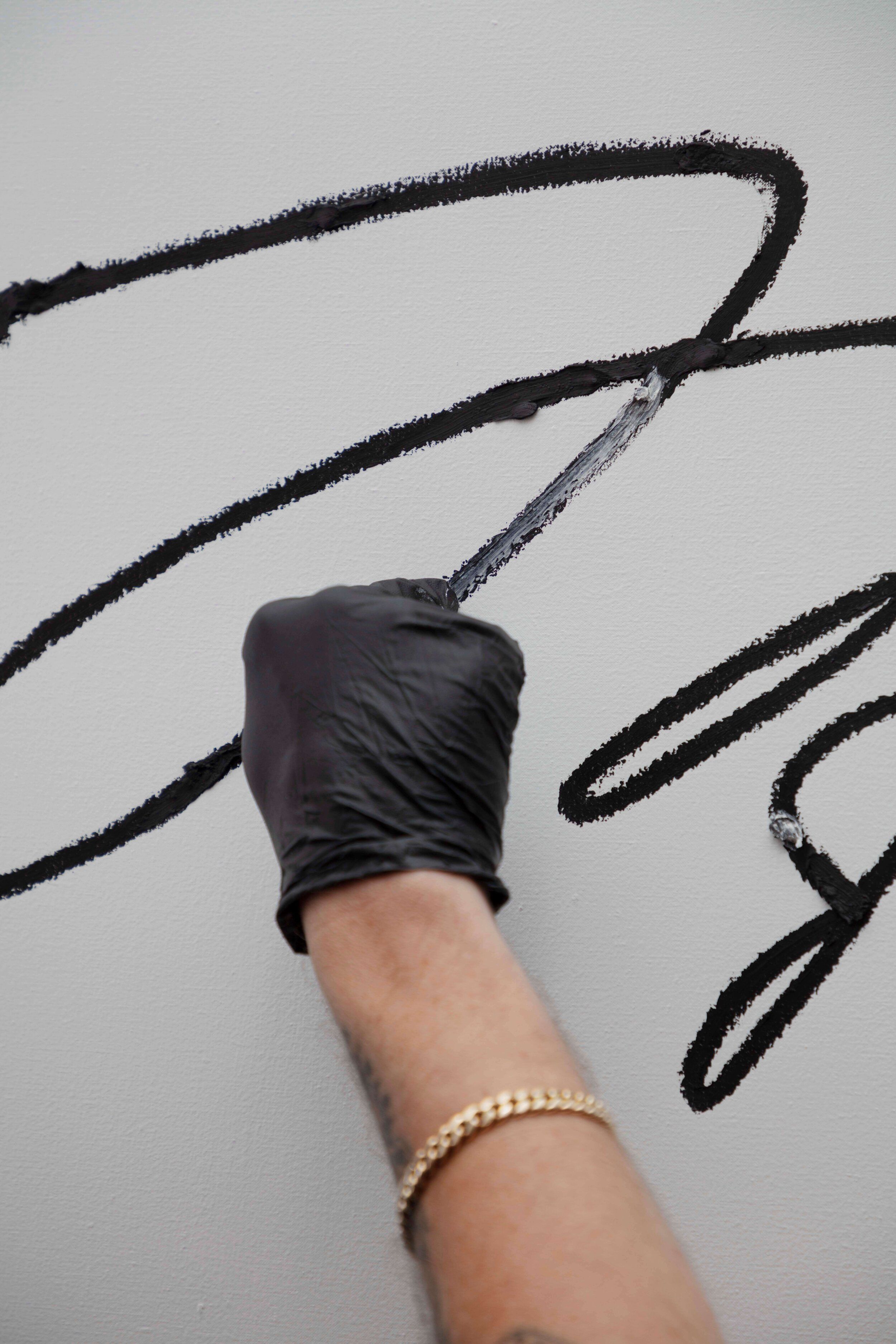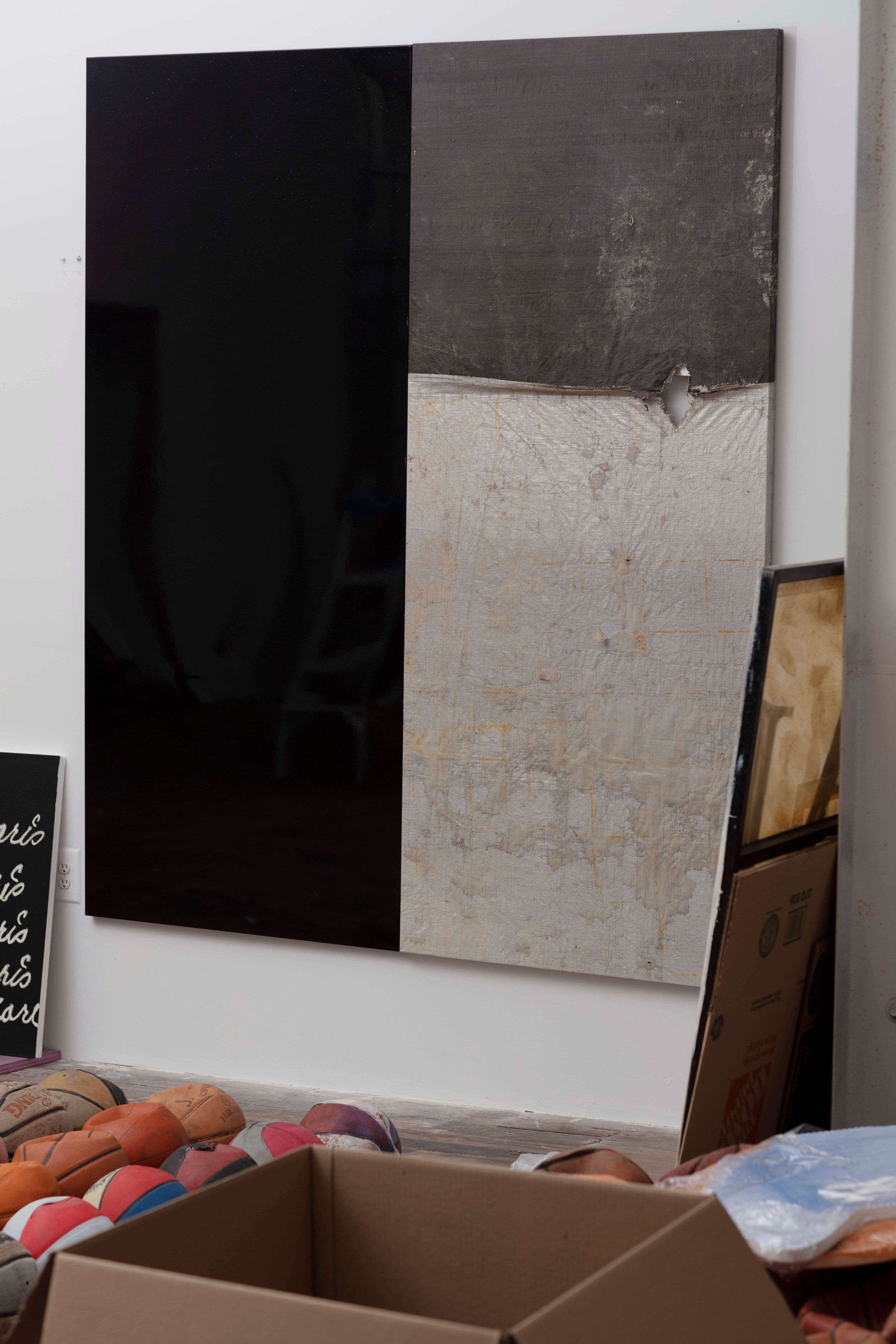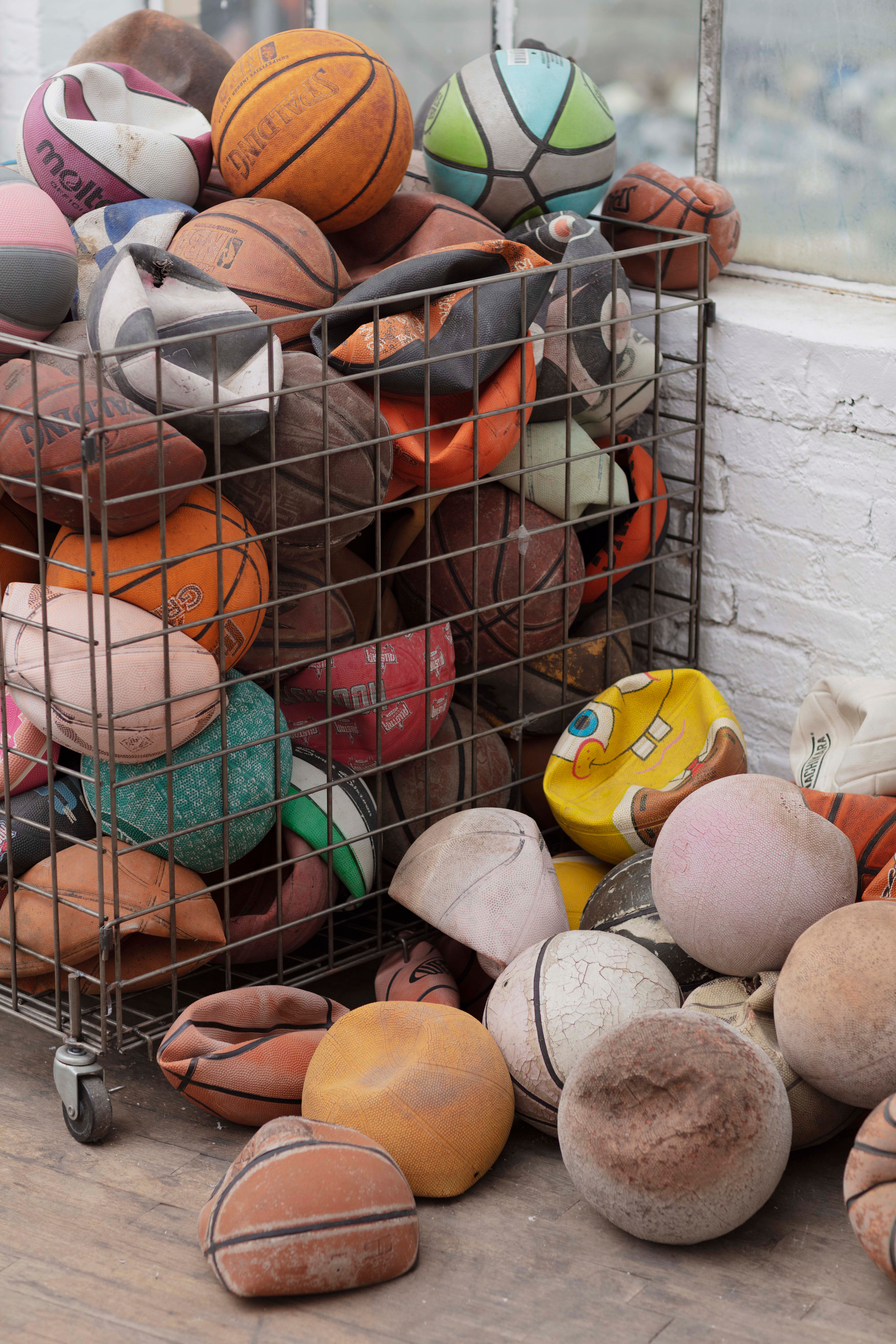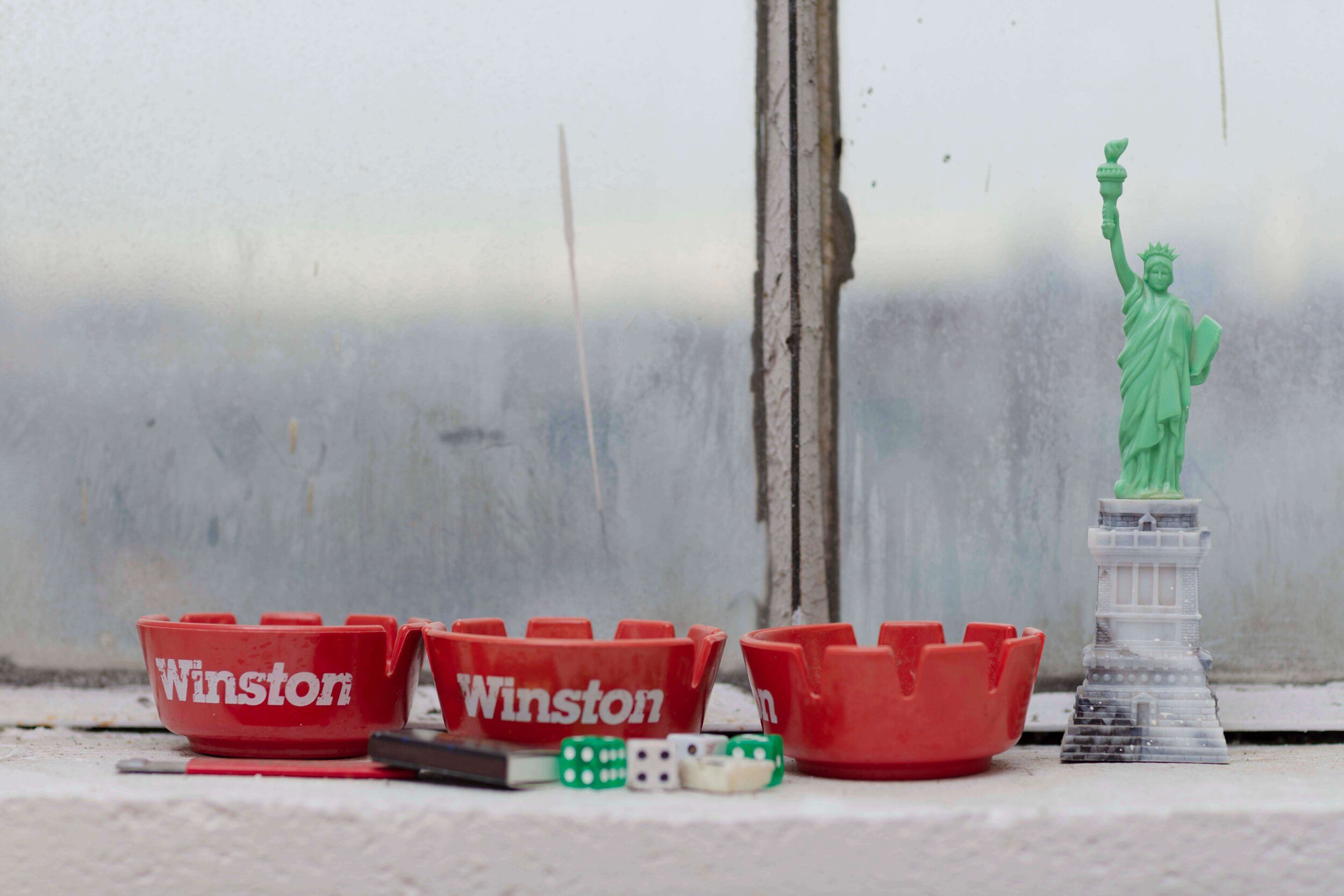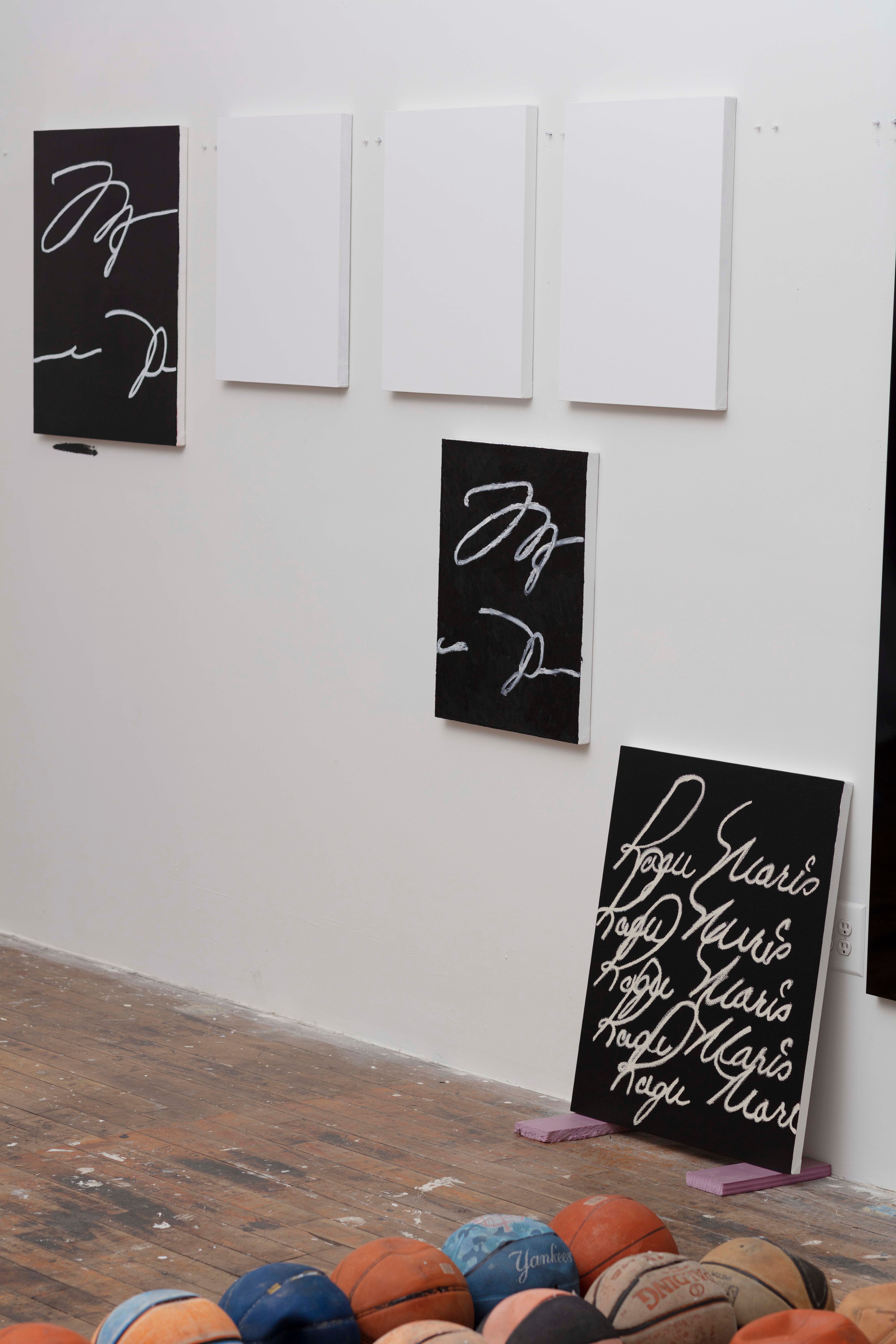
Anatomy is a platform that dissects and narrows in on the various parts of an artist’s practice through the lens of their studio. This presentation will provide a glimpse into an artist’s background and process through a multimedia tour including video, audio clips, imagery, and conversations with fellow artists, curators, and other figures who have been influential in shaping and understanding these creators and their works. Anatomy's intent is to examine the myriad of ways in which an artist finds inspiration, merges art and life, and is driven by experience and the people that come into their world. We hope that this glimpse into the lifeblood of the artist’s practice will affect an even deeper reading of the works included and those yet to come.
Background

Within Anatomy: Tyrrell Winston, the New York-based multimedia artist explores the narratives around sport fanaticism and the cult of the celebrity athlete. Through performance and appropriation, Winston co-opts signatures and memorabilia through acts of vandalism and forgery, challenging the value of signed objects and ideas around fame, grandiosity, and authenticity.
Within sports memorabilia and other forms of collecting (including contemporary art), markets are subject to an unstable process by which items fluctuate in value. In an article called ‘Collecting Celebrity: The Meanings and Process of Collecting Sports Memorabilia,’ authors Nancy E. Spencer, Jacquelyn Cuneen and Raymond Schneider assert that reliquism throughout the ages has been challenged in distinguishing between fame and infamy. Because there is such high value placed on artifacts that are distinctive or even notorious, collectors will search for tokens of “great saints and sinners, great philosophers and quacks, great conquerors, murderers, ministers, and thieves.” This informal process of valuation follows an uncertain course that reflects a number of factors including demand; celebrity “Q”; performance; availability; ever-changing fan and collector temperament; and an unlimited number of other conditions including the arbitrary opinions of “trendy appraisers.” It is this ineffable judgement of value and the disorientation between fame and infamy that intrigues Winston and has inspired his foray into painting and performance.
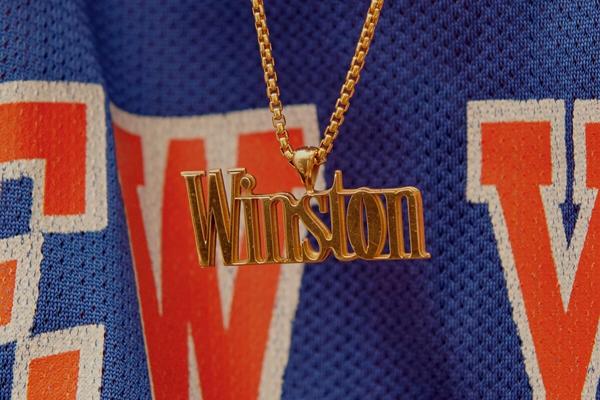
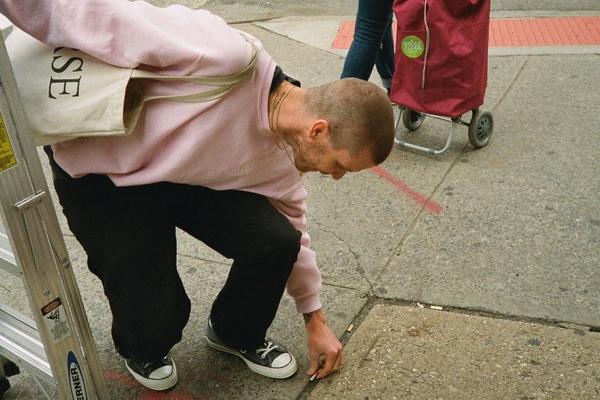

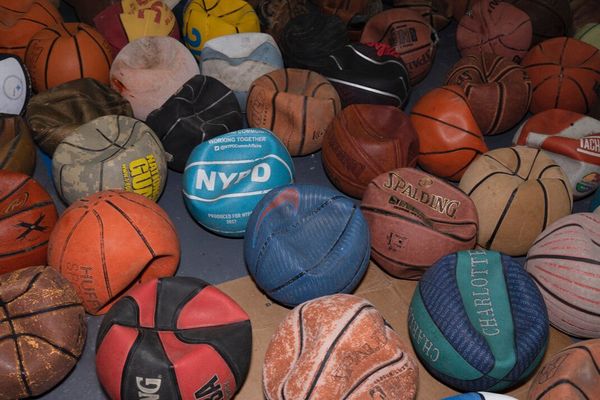
Inspiration


Robert Rauschenberg’s Erased de Kooning Drawing, 1953
Tyrrell Winston is inspired by acts of insertion and relations between a subject and their predecessors. Robert Rauschenberg’s Erased de Kooning Drawing (1953) is one such source of inspiration, and is referenced by Winston in his studio interview below. Rauschenberg’s tremendous respect for de Kooning was the impetus for using the artist’s work for this act of erasure. Rauschenberg had recognized that the erasure of an artwork would only hold meaning if value had already been assigned to that object. Similarly, Ai Weiwei’s famous Dropping a Han Dynasty Urn (1995) questions how cultural value is determined. Winston looks towards these artists and their work to question current systems of value, cultural significance, and celebrity.
“Erasing something, there is a level of vandalism to it but more so than anything it’s about resurrection through negation. Lord knows how many drawings de Kooning made over the course of his life, but the one that sticks out to me is actually Rauschenberg’s.”
— TYRRELL WINSTON
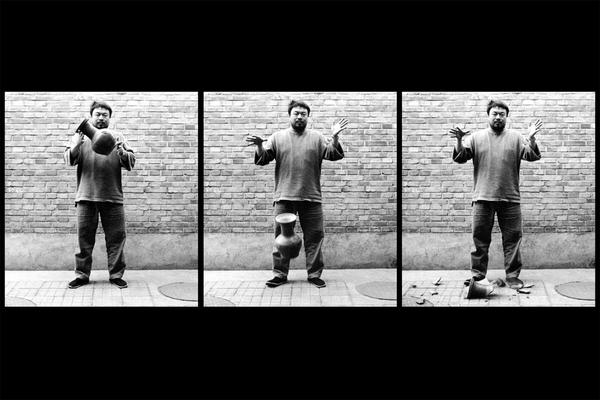




Artwork
Patriotism
Born Cassius Clay in Louisville, Kentucky in 1942, Muhammad Ali is one of the greatest boxers to have ever lived, and yet his role in advancing the civil rights movement in the 1960s made his fight in the political realm among his greatest accomplishments. Intrigued by Islamic doctrine from a young age, as a boy Clay saw a cartoon in a Nation of Islam Newspaper that depicted white slave owners forcing their slaves to pray to Jesus, and sited this experience as his revelation that Christianity was the religion of the oppressive white establishment. After winning his first heavyweight championship title in 1964, Clay publicly announced his conversion to Islam and changed his name to Muhammad Ali. His fans and the moderate Black community were torn by his affiliation with Elijah Muhammad and Malcolm X, but his conviction made him a hero when he refused to be inducted into the war in Vietnam on the grounds of race and religious belief: "Why should they ask me to put on a uniform and go 10,000 miles from home and drop bombs and bullets on brown people in Vietnam while so-called Negro people in Louisville are treated like dogs?" he told Sports Illustrated. Sportswriters and much of the public denounced him as a traitor, and the FBI subjected him to the same surveillance as Malcolm X and Martin Luther King Jr. (Blakemore). On June 20, 1967, Ali was convicted of violating the Selective Service Act and was sentenced to five years in prison; as a result, his boxing license was revoked, and he was stripped of his titles. By the time Ali won his appeal and the Supreme Court overturned his conviction, he had spent 3.5 years banned from his sport during a time of peak performance.
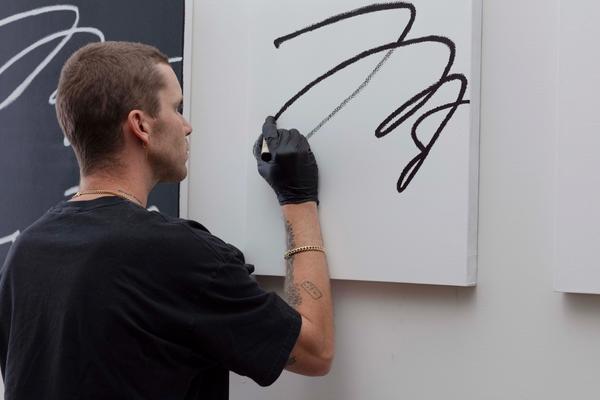
Strikeout
A 6X NBA Champion, Michael Jordan’s biography on the NBA website states: “[Jordan] was integral in helping to popularize the NBA around the world in the 1980s and 1990s, becoming a global cultural icon in the process.” The former NBA star is widely regarded as the most important figure to ever play basketball, and is a well-respected philanthropist, donating time and money over the years to the Make-a-Wish Foundation among numerous other charitable organizations. Jordan’s value to the economy has been estimated at over $10 billion dollars. Despite all this, Jordan has shouldered criticism over the years for his fierce competitive streak, a gambling addiction, and above all his repeated retirement from basketball and pursuit of success within Major League Baseball. Says Winston: “Jordan is remembered for his work ethic and winning 6 championships with the Chicago Bulls, but his attempt to play professional baseball brought global ridicule. This is insane to me; we should always encourage people to push boundaries into new frontiers.”
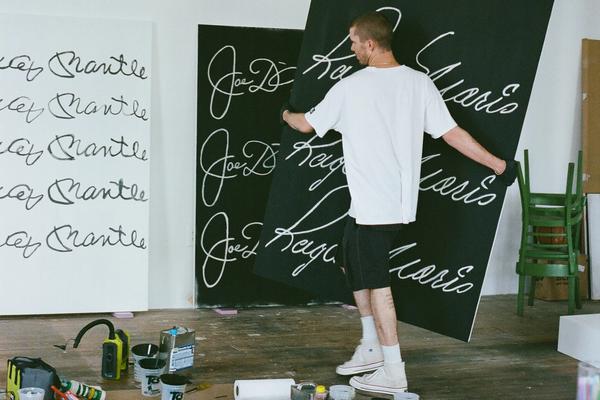
A View From Above
A 2X NBA champion and 4X NBA MVP, Wilt Chamberlain is the only professional basketball player to have ever scored 100 points in a single game - a record he achieved in 1962 that has yet to be met or broken. At 7ft 1in tall, he was a “Goliath” on the court and sustained regular hard fouls, often being double and triple-teamed to throw him off his game. The thrashing was so brutal that he considered retirement as a rookie, and according to former Celtics forward Tom Heinsohn, “He took the most brutal pounding of any player ever.” Heads above the other players in the 1960s, the NBA actually had to modify or change rules of the game in an attempt to make it more equitable for those who came up against him. His height prompted jeers from fans and scorn from the media, calling him a ‘freak of nature.’ Chamberlain also became known as professional sports’ consummate libertine, claiming to have slept with over 20,000 women in his lifetime. After the 1971 NBA playoffs, Chamberlain challenged heavyweight boxing legend Muhammad Ali to a fight - even preparing with Cus d’Amato, the trainer and adoptive father of Mike Tyson - but backed out of the bout, using a contractual escape clause that predicated Ali winning another fight that turned out to be his first professional loss. Upon retirement, Chamberlain made money in stocks and real estate; bought a Harlem nightclub that he named ‘Big Wilt’s Small Paradise’; and was cast as a villainous warrior alongside Arnold Schwarzenegger in ‘Conan the Destroyer’ (1984).

Leading The League in Clap
A 20X Allstar and 7X World Series Champion, Mickey Mantle is considered one of the greatest players, sluggers and switch hitters in American Baseball history. Outside of his sport, ‘the Mick’ was a known alcoholic with countless marriage infidelities; a playboy who brought both his wife and his mistress to his Yankees retirement ceremony in 1969. On the day of his 1974 enshrinement at the Baseball Hall of Fame, Mantle made a quick escape offstage after his acceptance speech, saying that the ceremony felt “Like a funeral. Like being buried alive” (Leavy). A decade after his departure from the Major Leagues, he maintained a life of luxury thanks to the sports memorabilia craze that swept the US in the 1980s, becoming a fixture at trade shows and card signings. At the age of 63, Mantle died due to complications from a lifetime of alcohol abuse. His 1995 Sports Illustrated Obituary states: “Acknowledging his pin-striped pedigree, the fascination [with Mantle] still doesn’t add up. If he was a pure talent, he was not a pure spirit... And still, looking at the slightly uplifted square jaw, all we see is America’s romance with boldness, its celebration of muscle, a continent’s comfort in power during a time when might did make it right.” Mantle’s rise and fall is characteristic of fame based on performance and youth, where decline is inevitable and yet the public continues to expect something more than human of their heroes.
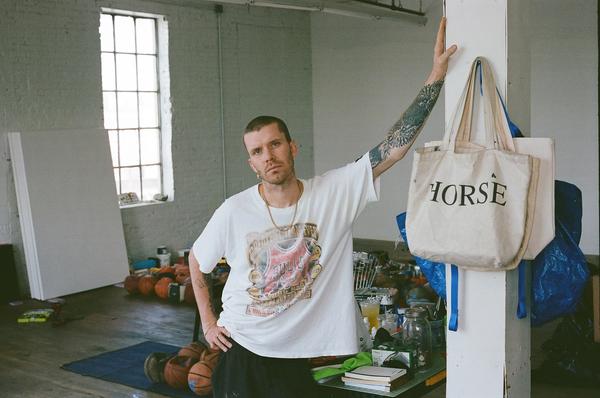
Signing Sessions
Winston’s endeavor into performance is captured in photographic documentation of acts of desecration, whereby the artist co-opts objects of signed memorabilia by some of history’s greatest athletes. Iconoclastic in the minds of sports fanatics and collectors of memorabilia, these actions affect notions of value depending on the sensibility of the viewer: have the balls been ruined and therefore made worthless (as so few of these authenticated balls exist); or have they taken on new significance as representations of a bridge between the collection of sports relics and contemporary art?
The artist was heavily influenced by a practice of vandalizing cultural artifacts and other significant works of art within art history. Robert Rauschenberg’s Erased de Kooning is of particular interest to Winston, considered a landmark of postmodernism because of its subversive appropriation of another artist’s work. Despite its immediate appearance as a disrespectful - even sacrilegious - act of defacement, Rauschenberg insisted, “It’s not a negation, it’s a celebration.”
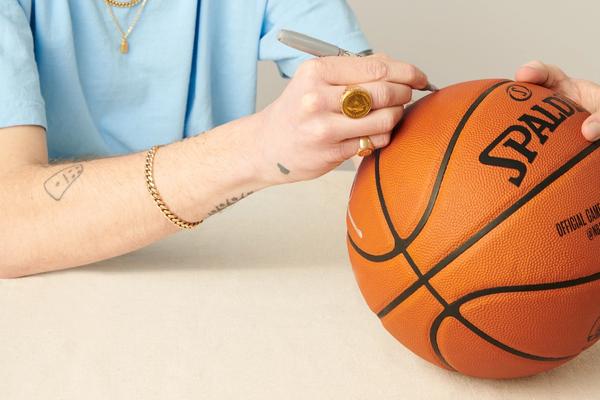
“Within the performance of creating these, there is a level of toying with and touching immortality. As a society we look up to these athletes—as flawed as some of them might be—as immortal and that’s one of the things we’re drawn to. We’re drawn to the legacy, to super human accomplishments. In desecrating that, they take on a new form of authorship and there is a lot of power in that gesture.”
— Tyrrell Winston
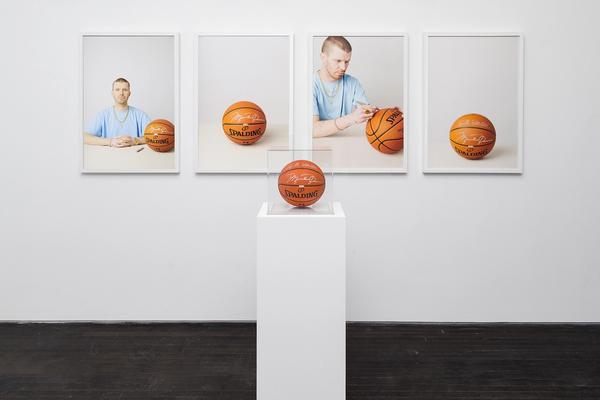
Knock, Knock
The market for Michael Jordan memorabilia has been among the most highly valued since his days with the Chicago Bulls, but has surged as of late with the release of ESPN’s series ‘The Last Dance.’ Although signed basketballs and autographed jerseys are iconic, collectors have been known to purchase just about anything related to Jordan’s legacy. From minor league baseball jerseys to McDonalds ‘McJordan’ BBQ sauce, to the ball he signed with Michael Jackson during the video shoot for ‘Jam’ in 1991, fans have sought out anything and everything the player has touched - the stranger and more unique, the better. Jordan’s significance as a cultural powerhouse has touched sports, media, fashion, hospitality and even the political realm, culminating in his reception of the Presidential Medal of Freedom from Barack Obama in 2016. The addition of Winston’s signature alongside Jordan’s becomes an act of appropriation but also one of vandalism, requiring the deliberate destruction of one cultural relic in an attempt to merge signifiers of art and sport to create another of unpredictable value.
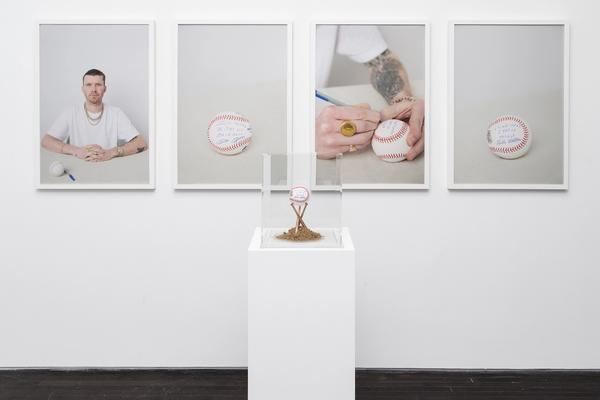
Charlie Hustle
Pete Rose wore the nickname ‘Charlie Hustle’ as a badge of honor after it was given to him in derision by Whitey Ford during his rookie year. Ford had pitched a walk during a spring training game against the New York Yankees and Rose sprinted to first base rather than jogging up the line. This was an early example of Rose’s affection for banter and controversy, and this type of conflict followed him throughout his career. He is Major League Baseball’s all-time hit leader but is just as well known for being caught gambling on the sport during his time as manager of the Cincinnati Reds (the team for which he played for 22 years). Rose was penalized with permanent ineligibility from baseball, and in 1991 the Baseball Hall of Fame formally voted to ban those on the ‘permanently ineligible’ list from induction. After years of public denial regarding the gambling allegations, Rose admitted in 2004 during a book tour to promote his autobiography that he bet on baseball and on the Reds. In 2010, it was reported that Rose used corked bats during his 1985 pursuit of Ty Cobb's record after two sports memorabilia collectors who owned his game-used bats from that season had them x-rayed and found the telltale signs of corking. Rose earns over $1 million annually from paid public appearances and autograph signings, and balls with the inscription ‘I’m sorry I bet on baseball’ were given privately to friends, Rose never expecting them to end up on the market. These balls present a particular moment of vulnerability, as other text Rose has signed often included jokes and one-liners such as ‘Hit King’. Winston presents a contrasting statement of exposure, stating ‘I’m not sorry I bet on myself’ in an adage of self-belief.
“The story of Pete Rose is an example of what it means to have someone’s life and career—and notions of greatness—take form within an object.”
— Tyrrell Winston
Conversations

Laura Mott, Curator

Tyrrell Winston discusses his work in relation to ideas of celebrity, nostalgia, and systems of value with Laura Mott, Senior Curator of Contemporary Art and Design at Cranbrook Art Museum.
Mott joined the Cranbrook Art Museum in November 2013 following an active career as a curator and lecturer in both the United States and Europe. A selection of her curated exhibitions include Landlord Colors: On Art, Economy, and Materiality (2019); Binion/Saarinen: A McArthur Binion Project (2018); Maya Stovall: Liquor Store Theater (2017); Nick Cave: Here Hear (2015) amongst many others. She is a graduate of the Center for Curatorial Studies, Bard College, New York (MA in Curatorial Studies), and the University of Texas (BFA in Art History and a BA in Studio Art).
“In this act of desecration the question is: what is it that we are desecrating? You understand that there’s this object that was handheld and there’s the signature, and it touches this notion of nostalgia. What are the memories that make them valuable? With the Pete Rose work, he was this figure who fell from grace so even his own value has shifted in regards to the meaning of his autograph. What does that proximity mean? We combine this with our own personal memories, which also give it value.”
— Laura Mott
Virgil Abloh, Artist
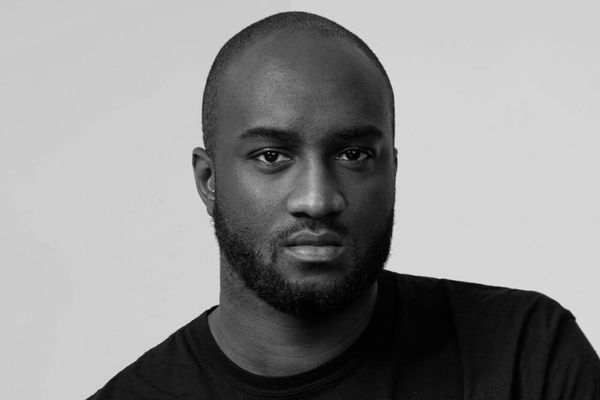
Virgil Abloh, a longtime supporter of Tyrrell Winton’s practice, connected with the artist to discuss systems of value and ideas of authorship in relation to Winston’s works for Anatomy. In this recorded phone conversation the two discuss how Winton co-opts the autographs of the legendary and the infamous to recontextualize existing systems of value, and how our current models for memorabilia are shifting from the tactile to the digital.
Abloh is an artist, architect, and the artistic director of Louis Vuitton's Menswear. After earning a degree in Civil Engineering from the University of Wisconsin-Madison, he obtained a master’s degree in Architecture at the Illinois Institute of Technology. It was at the Illinois Institute of Technology where Abloh was introduced to a curriculum established by Mies van der Rohe, formed from the notions of Bauhaus, that taught him to combine the fields of art, craft and design. These theories, merged with contemporary culture, makeup Abloh’s interdisciplinary practice today.
“That signature of another human being, if I get close enough to a relic or an artifact of that human being [there’s that sense that] I then become more valuable. It’s the same thing if I saw Duchamp’s Fountain or an original Picasso or the Mona Lisa, I’ll wait in line all day to sort of get that ‘signature’. But obviously [this is considered] through the lens of 1990, and the ‘96 Bulls, and a fire red Range Rover that becomes different; you know, it’s our language, it’s a different community’s Mona Lisa.”
— Virgil Abloh
Daniel Arsham, Artist
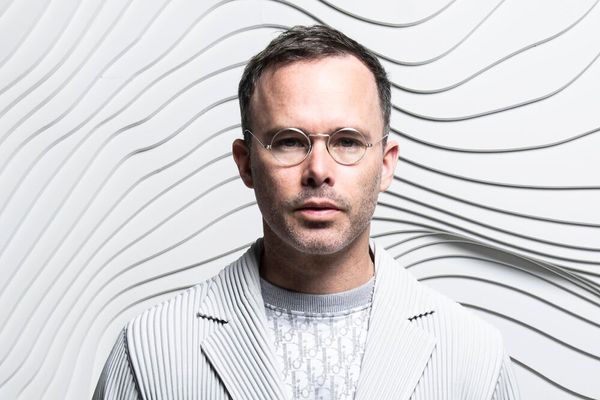
Multidisciplinary artist Daniel Arsham sat down with Tyrrell Winston to discuss the concepts and influences that drive their work. Their conversation highlights the similarities and differences between their practices, touching upon the subjects of contemporary culture and sport; time and decay; and interpretation by a wide array of audiences.
Arsham’s work has been shown at PS1 in New York, The Museum of Contemporary Art in Miami, The Athens Biennale in Athens, Greece, The New Museum in New York, Mills College Art Museum in Oakland, California and Carré d’Art de Nîmes, France among others.
“In your work the object itself is not altered—it’s the ideas about the inherent nature of age and decay, and the transformation of something that’s new and has been used or has sat out on the street.”
— Daniel Arsham
Studio Visit
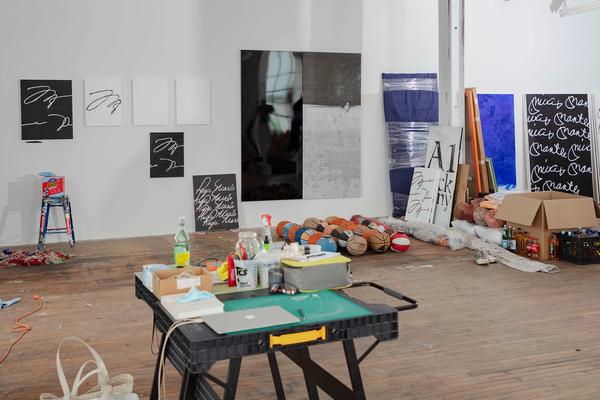
“I’m drawn to the character and texture of found and used objects. Natural wear and weather are powerful assistants.”
— TYRRELL WINSTON
Listen to Tyrrell Winston's studio playlist.
